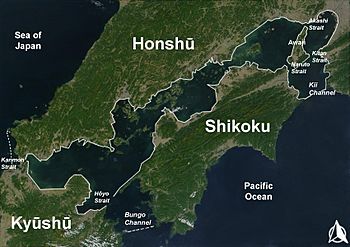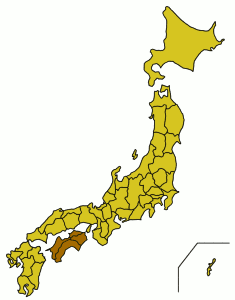Shikoku facts for kids
|
Native name:
四国
|
|
|---|---|

The island of Shikoku, Japan
|
|
 |
|
| Geography | |
| Location | Japan |
| Archipelago | Japanese archipelago |
| Area | 18,800 km2 (7,300 sq mi) |
| Area rank | 50th |
| Length | 225 km (139.8 mi) |
| Width | 50–150 km (31–93 mi) |
| Highest elevation | 1,982 m (6,503 ft) |
| Highest point | Mount Ishizuchi |
| Administration | |
| Prefectures | |
| Largest settlement | Matsuyama (pop. 514,865) |
| Demographics | |
| Population | 3,845,534 (2015) |
| Pop. density | 204.55 /km2 (529.78 /sq mi) |
| Ethnic groups | Japanese |
Shikoku (四国) is one of the four main islands of Japan. It is the smallest of these main islands.
Shikoku is located southeast of Honshū and northwest of Kyūshū. These islands are separated by the Kanmon Strait.
Farming is a very important activity on Shikoku. Farmers grow many different crops, and citrus fruits are a major product. Shikoku is also famous for a special journey called the 88 Temple Pilgrimage. This pilgrimage is important to the Shingon sect of Buddhism.
Contents
What are the Regions of Shikoku?
The Shikoku region covers the entire island. The name "Shikoku" means "four countries" in Japanese.
Long ago, Shikoku was divided into four old "countries" or provinces. These old provinces are now called prefectures. Each prefecture has a modern name and an old provincial name. People sometimes still use the old names, especially when talking about local foods, music, or art.
- Ehime: This prefecture is in the west. Its old name was Iyo Province.
- Kagawa: Located in the north, it was once called Sanuki Province.
- Kōchi: This prefecture is in the south. Its old name was Tosa Province.
- Tokushima: Found in the east, it was formerly known as Awa Province.
Which are the Main Cities in Shikoku?
Shikoku has several important cities, each with unique features.
- Kōchi: This city is famous for its "Yosakoi" festival and many local sights.
- Matsuyama: It is well-known for the ancient hot springs at Dogo Onsen.
- Takamatsu: This is the largest city on Shikoku island.
- Tokushima: It hosts the famous Awa Odori festival every August.
- Uwajima: This city has a special shrine and unique bull wrestling events.
- Naruto: Often called the "east gate" of Shikoku, known for its whirlpools.
What are the Main Points of Interest?
Shikoku offers many interesting places to visit, from natural wonders to historic sites.
- Cape Ashizuri: This is a beautiful cape located at the southernmost tip of Shikoku.
- Iya Valley: A remote but very scenic mountain valley, perfect for exploring nature.
- Kotohira: This town is home to the famous Kompira-san shrine.
- Mount Ishizuchi: This is the tallest mountain peak on the island of Shikoku.
Historic Castles in Shikoku
Japan has only twelve original castles left, and four of them are found on Shikoku. These castles are very old and have not been rebuilt.
Temples and Shrines: The 88 Temple Pilgrimage
The 88 Temple Pilgrimage is a very famous and challenging journey. It is a 1,647-kilometer circle around the entire island.
Some serious pilgrims choose to walk the entire 88 Temple Circuit. Others use buses or cars to complete the journey. It is a spiritual and cultural experience.
Related pages
Images for kids
-
The Chūgoku region and Shikoku as seen from the International Space Station.
-
A dish of Sanuki udon noodles.
-
A soccer match from the J1 League (featuring Tokushima Vortis).
-
Anraku-ji temple in Kamiita, Tokushima.
-
A panoramic view of Matsuyama City.
-
A view of Takamatsu City.
-
A view of Kōchi City from Kochi Castle.
-
A distant view of Tokushima City from Shiroyama.
See also
 In Spanish: Región de Shikoku para niños
In Spanish: Región de Shikoku para niños

















